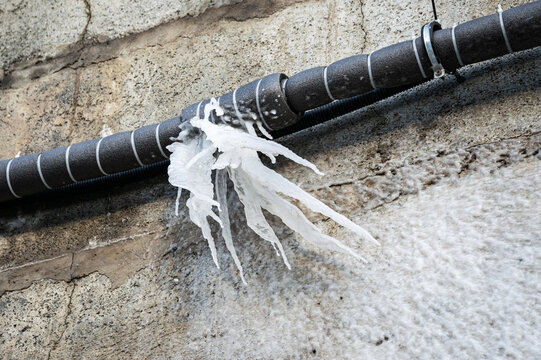Safeguarding Pipes from Freezing Damage: Key Tips
Safeguarding Pipes from Freezing Damage: Key Tips
Blog Article
The publisher is making several great observations on the subject of Helpful Tips to Prevent Frozen Pipes this Winter overall in the content directly below.

Cold weather can damage your plumbing, particularly by freezing pipelines. Below's how to prevent it from happening and what to do if it does.
Introduction
As temperatures drop, the risk of frozen pipelines rises, possibly causing pricey repair services and water damages. Recognizing exactly how to prevent icy pipes is crucial for home owners in chilly climates.
Recognizing Icy Pipes
What triggers pipelines to ice up?
Pipelines freeze when exposed to temperatures listed below 32 ° F (0 ° C) for expanded periods. As water inside the pipelines ices up, it broadens, taxing the pipeline wall surfaces and potentially triggering them to burst.
Dangers and damages
Frozen pipes can bring about water system disruptions, building damage, and pricey repairs. Burst pipes can flooding homes and trigger substantial architectural damages.
Indicators of Frozen Piping
Recognizing icy pipelines early can stop them from breaking.
Just how to identify icy pipes
Search for decreased water circulation from taps, uncommon smells or noises from pipes, and noticeable frost on revealed pipelines.
Prevention Tips
Protecting at risk pipelines
Wrap pipelines in insulation sleeves or utilize warmth tape to shield them from freezing temperatures. Concentrate on pipes in unheated or outside areas of the home.
Home heating techniques
Maintain interior areas appropriately heated, particularly locations with plumbing. Open up cabinet doors to enable cozy air to circulate around pipes under sinks.
Safeguarding Exterior Pipes
Yard hoses and outdoor faucets
Disconnect and drain garden tubes prior to winter. Install frost-proof spigots or cover outdoor faucets with protected caps.
What to Do If Your Pipes Freeze
Immediate actions to take
If you believe icy pipelines, keep faucets open to relieve pressure as the ice thaws. Utilize a hairdryer or towels soaked in warm water to thaw pipes gradually.
Long-Term Solutions
Architectural modifications
Think about rerouting pipelines far from outside walls or unheated areas. Include extra insulation to attic rooms, basements, and crawl spaces.
Upgrading insulation
Buy top notch insulation for pipelines, attic rooms, and wall surfaces. Proper insulation assists keep regular temperatures and minimizes the threat of frozen pipelines.
Final thought
Avoiding frozen pipelines requires positive actions and quick reactions. By comprehending the causes, indications, and preventive measures, property owners can protect their pipes throughout cold weather.
6 Proven Ways to Prevent Frozen Pipes and Protect Your Home
Disconnect and Drain Garden Hoses
Before winter arrives, start by disconnecting your garden hoses and draining any remaining water. Close the shut-off valves that supply outdoor hose bibs and leave the outdoor faucet open to allow any residual water to drain. For extra protection, consider using faucet covers throughout the colder months. It’s also important to drain water from any sprinkler supply lines following the manufacturer’s directions.
Insulate Exposed Pipes
Insulating your pipes is an effective way to prevent freezing. Pipe insulation is readily available at home improvement stores and is relatively inexpensive. Pay close attention to pipes in unheated areas such as the attic, basement, crawl spaces, or garage. Apply foam insulation generously to create a buffer against the cold. You can also wrap your pipes in heat tape or thermostat-controlled heat cables for added warmth.
Seal Air Leaks
Inspect your home for any cracks or openings that could let in cold air. Seal any holes around the piping in interior or exterior walls, as well as the sill plates where your home rests on its foundation. Additionally, make sure to keep your garage door closed unless you’re entering or exiting. Leaving it open creates a significant air leak that can lead to frozen pipes.
Allow Warm Air Circulation
During cold snaps, it’s essential to allow warm air to circulate evenly throughout your home. Leave interior doors ajar to promote better airflow. Open kitchen and bathroom cabinets to help distribute heat consistently around the rooms. If you have small children or pets, be sure to remove any household chemicals or potentially harmful cleaners from open cabinets for safety.
Let Faucets Drip
A small trickle of water can make a big difference in preventing ice formation inside your pipes. When temperatures drop significantly, start a drip of water from all faucets served by exposed pipes. This continuous flow helps prevent the water from freezing. Additionally, running a few faucets slightly can relieve pressure inside the pipes, reducing the chances of a rupture if the water inside does freeze.
https://choateshvac.com/6-proven-ways-to-prevent-frozen-pipes-and-protect-your-home/

We are very occupied with Preventing and dealing with frozen pipes and I am hoping you enjoyed our article. Enjoyed reading our posting? Please quickly share it. Help other people find it. I appreciate reading our article about Preventing and dealing with frozen pipes.
Source This Article Report this page